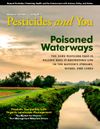14
Dec
UK Rivers Contaminated with Neonicotinoids; EU Delays Decision to Extend Ban
(Beyond Pesticides, December 14, 2017) Tests of waterways in the United Kingdom (UK) reveal rivers contaminated with  neonicotinoids, the class of chemicals highly toxic to bees and aquatic invertebrates. And now, although neonicotinoids were banned from use on certain crops in the European Union (EU) in 2013, an EU vote to extend the ban has been delayed.
neonicotinoids, the class of chemicals highly toxic to bees and aquatic invertebrates. And now, although neonicotinoids were banned from use on certain crops in the European Union (EU) in 2013, an EU vote to extend the ban has been delayed.
The test results raise concerns over neonicotinoids’ impacts on waterways, especially to fish and birds. Under a new EU mandate -Water Framework Directive ‘Watch List’ initiative – the UK was required to monitor for all five commonly used neonicotinoids: imidacloprid, clothianidin, thiamethoxam, acetamiprid and thiacloprid. Twenty-three sites were sampled in 2016, 16 in England, four in Scotland, three in Wales and three in Northern Ireland.
This is the first systematic testing of neonicotinoids in rivers in Britain. According to the results, half the rivers tested in England had either chronic or acute levels of contamination. Of the 23 rivers tested across Britain, all but six contain neonicotinoids. Eight rivers in England exceed recommended chronic pollution limits, and two are acutely polluted.
Neonicotinoids are not only highly toxic to bees but also highly toxic to aquatic insects, which are a vital food source to fish and birds. In its recently released 2017 Preliminary Aquatic Risk Assessment for Imidacloprid, the U.S. Environmental Protection Agency (EPA) finds that aquatic invertebrates, especially keystone aquatic insects like the mayfly – basic to aquatic food chains, are sensitive to imidacloprid. Further, current imidacloprid levels detected in streams, rivers, lakes, and drainage canals exceed acute and chronic toxicity endpoints. Impacts occur at low concentrations and can result in decreased species abundance, altered predator-prey relationships, and reduced nutrient cycling.
According to the environmental group, BugLife, which reported on the UK results, the River Waveney on the Norfolk/Suffolk border is the most polluted river, with the acute harm level exceeded for a whole month, and the River Wensum in Norfolk, an area identified for special conservation, is also chronically polluted. Waveney and Wensum rivers, both containing residues of clothianidin and thiamethoxam, supply the Broads, an internationally important wetland site and home to many endangered aquatic animals. They note that nearby sugar beet fields are the most likely source of neonicotinoid contamination. Rivers near urban areas have higher levels of imidacloprid. No official limits exist in the EU for neonicotinoids in freshwater.
The European Commission met December 12 and 13, 2017 to decide on a proposal to extend the 2013 neonicotinoid ban to all outdoor crops, but this decision was delayed. The Standing Committee on Plants, Animals, Food and Feed discussed proposals for an expanded ban, but no vote was taken. The issue is expected to be on the agenda again in early 2018. The UK government has reversed its previous stance on neonicotinoids, now saying that it should be banned due to their harm to pollinators.
After its recent aquatic analysis, EPA quietly adjusted its aquatic benchmarks for imidacloprid to 0.385 ug/L for acute risks (down from 34.5ug/L) and 0.01 ug/L for chronic risks (down from 1.05 ug/L), reflecting the high toxicity of imidacloprid to aquatic invertebrates. Independent studies have shown impacts to aquatic life occurring at levels as low as 0.65 ug/L for acute toxicity and 0.03 ug/L for chronic toxicity.
Earlier this year, Beyond Pesticides released Poisoned Waterways, a report which documents the persistence of neonicotinoids in U.S. waterbodies and the danger they cause to aquatic organisms, resulting in complex cascading impacts on the aquatic food web. The report also highlights current regulatory failures of EPA aquatic standards, which continue to underestimate risks to sensitive species due to a reliance on test protocols that do not reflect real-world exposures or susceptibilities. Aquatic standards, which have been underestimating risks to sensitive species due to a reliance on test protocols, do not reflect real-world exposures or susceptibilities.
All unattributed positions and opinions in this piece are those of Beyond Pesticides.
Source: The Guardian, BugLife, Farming UK










